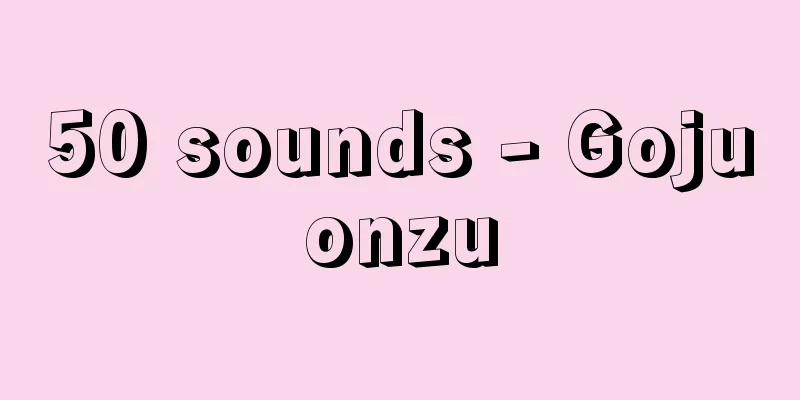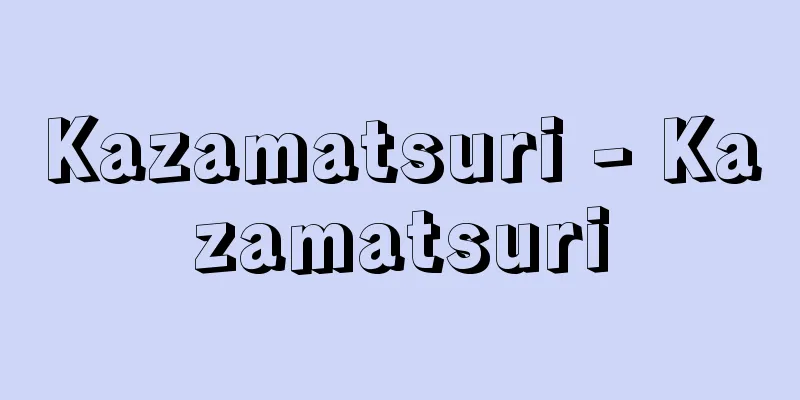50 sounds - Gojuonzu

|
A chart showing 50 kana characters arranged vertically in 10 rows of 5 characters each. In the past, it was also called "Go-on" or "Go-on Goi no Shidai." The five characters vertically are called "rows," and the ten characters horizontally are called "stages (or columns)." In the past, it was typically written in katakana or man'yōgana, but in recent years it is often written in hiragana. In principle, the Gojuon Chart is a table that organizes the pronunciations of each kana that share common consonant elements into rows and common vowel elements into columns. Therefore, it should have originally shown 50 different pronunciations, but today many of the sounds are homophones and indistinguishable (e.g. I and I), making it insufficient as a list of syllables. Furthermore, even going back to ancient times, it has not been confirmed that I in the Ya row and U in the Wa row existed as separate phonemes from the A row. However, it is extremely useful as a table to explain various phonological changes in Japanese and the phonetic alternations seen in conjugation forms ( ame - amagasa , kana nai , kamamasu , etc.), and even today it is widely used, mainly in school education, in a revised form for the Ya and Wa rows. Furthermore, because it contains all the kana, is systematic, and is easy to remember, it is used as a standard for arranging words (in alphabetical order) in dictionaries and directories. The oldest surviving Gojuon chart is an appendix to the "Kujakukyo Ongi" (a copy from the end of the Heian period) in the Daigoji Temple. It begins with "Kikokakeku," which is different from the current order in both rows and columns. As can be seen, the order of the arrangement in older works was not consistent, and it was only after the Northern and Southern Courts period that it was fixed into its current form. Incidentally, the current order is clearly based on the Siddham chapter (a Sanskrit alphabet table), but the origin of the Gojuon chart itself is thought to have been created for the convenience of the Japanese phonological table or the hansetsu (cutting and turning) of Chinese characters. It was created in the early Heian period, and was probably born in the world of academic research among Buddhist monks. [Kondo Yasuhiro] "Thoughts on the Sound Chart and Songs of Handwriting Practice" by Oya Toru (1918, Dai Nippon Tosho/Reprint edition, 1969, Benseisha)" ▽ "The History of the Fifty Sound Chart" by Yamada Takao (1938, Hobunkan)" ▽ "Studies on the Phonology of the Japanese Language" by Hashimoto Shinkichi (1950, Iwanami Shoten)" ▽ "Studies on the History of Japanese Rhyming" by Mabuchi Kazuo (1963, Japan Society for the Promotion of Science) ©Shogakukan "> The Japanese Alphabet Source: Shogakukan Encyclopedia Nipponica About Encyclopedia Nipponica Information | Legend |
|
50字の仮名を、縦に5字ずつ10行に並べた図表。 古くは「五音」「五音五位之次第」などともよばれた。また、縦の5字を「行」といい、横の10字を「段(または列)」という。古くは片仮名や万葉仮名で書かれるのが例であったが、近年では平仮名で書かれることも多い。 五十音図は、原理としては、それぞれの仮名の発音のうち、子音要素の共通するものを行に、母音要素の共通するものを段にまとめたものである。したがって、本来は50の異なった発音を示しているべきであるが、現在では同音となって区別のないものも多く(イとヰなど)、音節の一覧表としては不十分なものとなっている。また、古くさかのぼっても、ヤ行のイ、ワ行のウなどは、ア行のものと別の音韻として存在したことは確かめられていない。しかし、日本語における各種の音韻変化や、活用形にみられる音韻交替(あめ―あまがさ、書かない、書きます等)を説明する表としてきわめて便利なものであり、現在でもヤ行・ワ行を改編した形で学校教育を中心として広く用いられている。さらに、仮名をすべて含んでいて体系的で記憶しやすいことから、辞典・名簿などで語の配列の基準(五十音順)として用いられている。 現存する最古の五十音図は、醍醐(だいご)寺蔵の『孔雀(くじゃく)経音義』(平安時代末期写)に付記されたものである。これは行も段も現行の順序とは異なり「キコカケク」から始まっている。このように、古い時代のものは配列の順序が一定せず、現在の形に一定したのは南北朝時代以降のことである。なお、現在の順序は明らかに悉曇(しったん)章(サンスクリットの字母表)に基づくものであるが、五十音図の起源自体は、むしろ日本語の音韻表あるいは漢字音の反切(はんせつ)の便宜のためにつくられたものとみられている。成立年代は平安時代の初期であり、おそらく僧侶(そうりょ)の学問研究の世界で生まれたものであろう。 [近藤泰弘] 『大矢透著『音図及手習詞歌考』(1918・大日本図書/復刻版・1969・勉誠社)』▽『山田孝雄著『五十音図の歴史』(1938・宝文館)』▽『橋本進吉著『国語音韻の研究』(1950・岩波書店)』▽『馬淵和夫著『日本韻学史の研究』(1963・日本学術振興会)』 ©Shogakukan"> 五十音図 出典 小学館 日本大百科全書(ニッポニカ)日本大百科全書(ニッポニカ)について 情報 | 凡例 |
>>: Goshui Wakashu - Goshui Wakashu
Recommend
Francesco Severi
1879‐1961 Italian mathematician and central figure...
Bononia
...It is a strategic point for water, land and ai...
Terracotta - Terracotta (English spelling) Italian
The original meaning is baked earth, red clay, or...
Oriya - Oriyago
...There is a considerable movement of population...
Antifogging coated glass
When the glass is used under conditions that cause...
Anti-crease finish (anti-wrinkle finish)
This refers to a process that makes fabric less su...
Aneurysm - aneurysm
A condition in which the arterial lumen expands i...
normal strain
…( d - d 0 )/ d 0 is called the transverse strain...
Ogino
One of the surnames. [Additional information] Peop...
Alouatta seniculus (English spelling) Alouattaseniculus
...The name comes from the loud and varied calls ...
Campidano Plain - Campidano Plain
…About four-fifths of the island is occupied by m...
Atahualpa - Atahualpa (English spelling)
The last emperor of the Inca Empire. Illegitimate...
Ganyan - Ganyan
... Hacienda management is broadly divided into t...
Kotobuki Kyogen
〘Noun〙 A commemorative kyogen play that has been p...
Gasoline engine - Gasoline engine
A type of internal combustion engine that uses gas...









